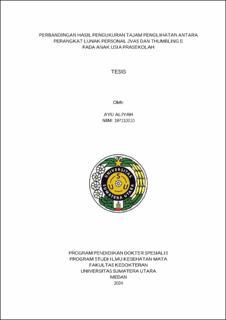| dc.description.abstract | Background: Visual acuity measurement is a crucial aspect of evaluating eye health function in both adult and pediatric populations. Establishing an individual's visual acuity quality allows for more optimal identification of underlying pathologies. Preschool-aged children, in particular, warrant special attention in this population due to the challenge of communicating complaints, making it difficult to conduct visual acuity examinations. Various methods have been employed for measuring visual acuity in the pediatric population, especially in preschool-aged children, with matching methods being the most effective.
Objective: The researcher aims to compare the results of visual acuity measurements using the Jaeb Visual Acuity Screener (JVAS) and the Thumbling E Chart in preschool-aged children at TK Yayasan Raudhatu Bina Rabbani, Medan, North Sumatra.
Method: This study is an analytical study with a cross-sectional research design aimed at comparing the accuracy of visual acuity measurements using JVAS and Thumbling E.
Results: Based on the examination of the Thumbling E Chart against the gold standard examination in the right eye of preschool-aged children, it was found that the sensitivity of the Thumbling E Chart examination to the gold standard examination was 81.8%, specificity was 90.3%, positive predictive value (PPV) was 75%, negative predictive value (NPV) was 93.3%, and accuracy rate was 88.1% in the right eye and 100%, specificity was 90.2%, PPV was 79.3%, NPV was 100%, and accuracy rate was 92.9% in the left eye. Meanwhile, the accuracy value of the JVAS examination to the gold standard examination in the right eye showed that the sensitivity of the JVAS examination to the gold standard was 86.4%, specificity was 91.19%, PPV was 79.2%, NPV was 95%, and accuracy rate was 90.5% in the right eye and 95.7%, specificity was 83.6%, PPV was 68.8%, NPV was 98.1%, and accuracy rate was 89.6% in the left eye of preschool-aged children.
Conclusion: The specificity and sensitivity levels are almost similar in the application of examinations using the JVAS and Thumbling E Chart methods. | en_US |


